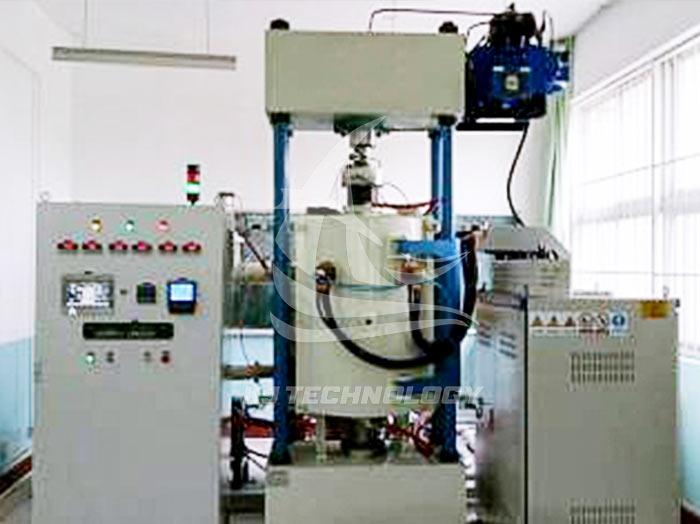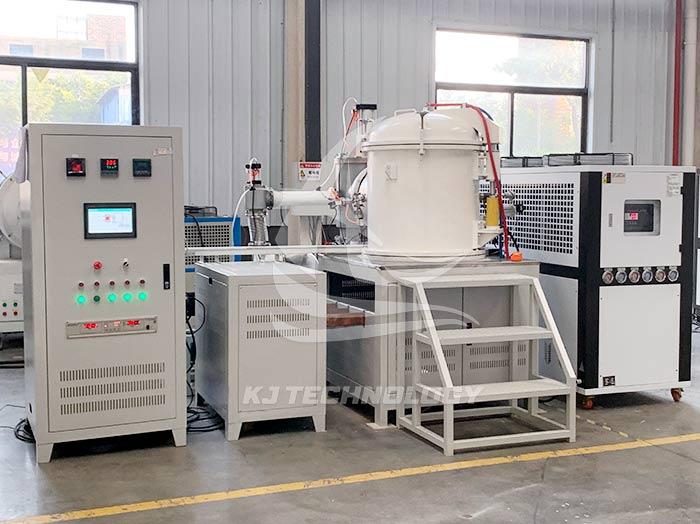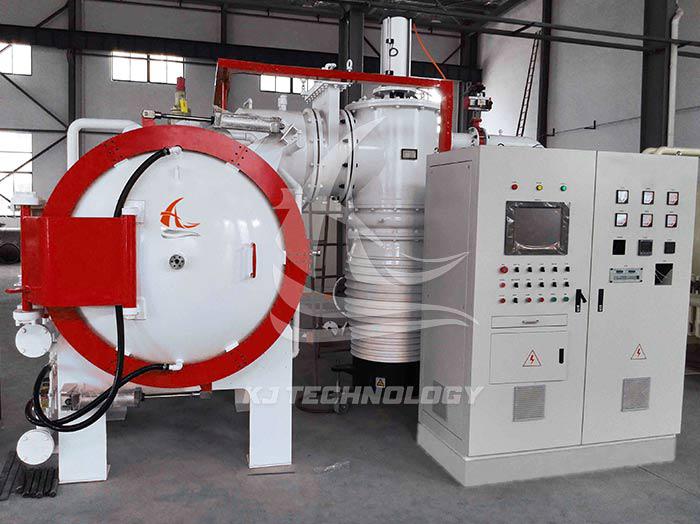Application of vertical high vacuum hot pressing electric furnace in the battery industry
 08-20-2025 Author: KJ technology
08-20-2025 Author: KJ technology
The vertical high vacuum hot pressing electric furnace is widely and crucially used in the battery industry. Through the synergistic effect of vacuum environment, high-temperature heating, and mechanical pressure, it significantly improves the performance and production efficiency of battery materials. The specific application scenarios and advantages are as follows:
1. Core application scenarios
Solid state electrolyte synthesis
Sulfide solid electrolyte: Highly sensitive to moisture and oxygen, it needs to be synthesized in an anhydrous and anaerobic environment. The vertical high vacuum hot pressing electric furnace integrates a glove box interface to achieve high-temperature sintering of materials in an inert atmosphere. The prepared electrolyte has high ionic conductivity (such as reaching the level of 10 ⁻ S/cm) and low interface impedance, laying the foundation for improving the performance of solid-state batteries.
Oxide solid electrolytes, such as LLZO (lithium lanthanum zirconium oxide), can eliminate grain boundary pores and improve ion mobility through hot pressing process. At the same time, abnormal grain growth can be suppressed by pressure to maintain material stability.
Lithium metal negative electrode protection
Dendrite inhibition: Lithium metal negative electrodes are prone to dendrite growth during charging and discharging, which can puncture the separator and cause short circuits. A vertical high vacuum hot pressing electric furnace combined with atomic layer deposition (ALD) technology is used to deposit inorganic protective layers (such as Al ₂ O3 LiF), By hot pressing, the protective layer is tightly bonded to lithium metal, effectively suppressing dendrite growth and improving cycling stability (increasing cycling times by more than 50%) and Coulombic efficiency (approaching 99%).
Recycling of waste battery materials
Lithium element recovery: Under vacuum conditions, efficient recovery of lithium elements from waste lithium-ion battery cathode materials (such as LiCoO ₂, NCM) is achieved through heat treatment and atmosphere control (recovery rate>95%). The electrochemical performance of recycled materials is close to that of commercial products, providing a green and efficient solution for the battery recycling industry.
Structural repair: Hot pressing technology can repair lattice defects in recycled materials, restore their ion diffusion channels, and improve material capacity retention.
2. Technical advantages
Precise atmosphere control
High vacuum degree: up to 10 ⁻⁵ Pa level, completely isolating active gases such as oxygen and nitrogen, preventing battery materials from oxidizing or decomposing at high temperatures (such as lithium metal easily oxidizing to form Li ₂ O in air).
Inert atmosphere protection: Supports the filling of inert gases such as argon and nitrogen to meet the differentiated requirements of different material systems for the atmosphere (such as sulfide electrolytes that need to be treated in dry argon).
Uniform temperature field
Double layer water-cooled furnace structure: The inner layer is made of stainless steel and the outer layer is made of carbon steel, combined with a metal resistance heating device, to achieve temperature uniformity within ± 5 ℃ inside the furnace, avoiding uneven material properties caused by local overheating.
Rapid heating rate: 5-10 ℃/min heating rate, shortening production cycle and improving single batch production capacity.
Controllable pressure application
Hydraulic system: Provides adjustable pressure of 5-100MPa to promote particle rearrangement and pore elimination, resulting in a density of over 99% for battery materials, significantly improving material hardness (such as 28GPa for silicon carbide ceramics) and impact resistance.
Pressure uniformity: The upper and lower pressure head system (optional TZM alloy or CFC carbon carbon composite fiber material) ensures uniform pressure distribution, avoiding material deformation or cracking.
Automation and Intelligence
PLC control system: realizes real-time monitoring and adjustment of process parameters (temperature, pressure, time), supports one click start and data storage functions, and improves production stability and repeatability.
Safety protection device: Built in mechanical protection devices such as water circuit pressure loss alarm and thermocouple automatic exit ensure the safe operation of the equipment.
3. Typical case
Development of Solid State Battery Electrolytes
Case: A battery company used a vertical high vacuum hot pressing electric furnace to prepare sulfide solid electrolytes. By optimizing pressure and temperature parameters (such as 1200 ℃, 30MPa), the electrolyte ion conductivity was increased to 10 ⁻ 2 S/cm, and the interface impedance was reduced to below 50 Ω· cm ². It was successfully applied to the development of solid battery prototypes.
Effect: The battery energy density is increased by 30%, and the cycle life is extended to over 1000 times, reaching the international advanced level.
Industrialization of lithium metal negative electrode
Case: A research team used a hot pressing electric furnace combined with ALD technology to deposit a 50nm thick Al ₂ O Ⅲ protective layer on the surface of lithium metal. Through hot pressing, the protective layer formed a dense interface with lithium metal, inhibiting dendrite growth.
Effect: The cycling stability of the lithium negative electrode has been improved by 80%, and the Coulombic efficiency has remained stable at over 99%, laying the foundation for the commercial application of lithium metal batteries.
Battery recycling material regeneration
Case: A recycling enterprise uses a hot press electric furnace to recover lithium elements and repair the structure of waste NCM positive electrode materials. By controlling the vacuum degree (10 ⁻ Pa) and temperature (800 ℃), the lithium recovery rate is 98% and the capacity retention rate of recycled materials is 95%.
Effect: The recycling cost is reduced by 40%, and the performance of recycled materials is close to that of native materials, promoting the sustainable development of the battery recycling industry.








